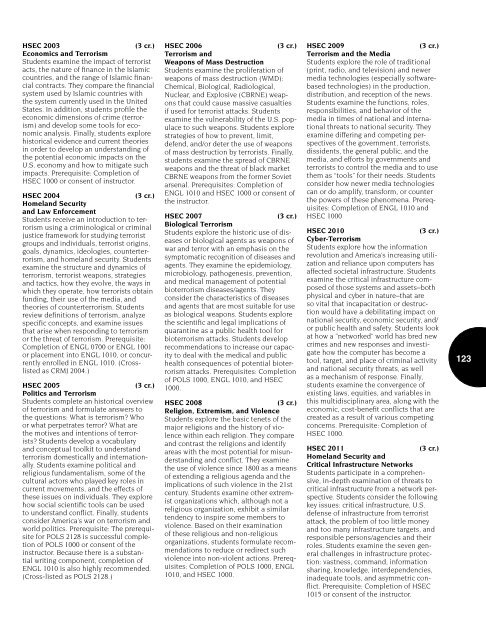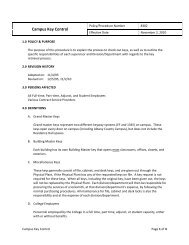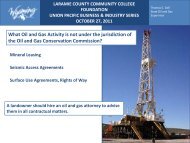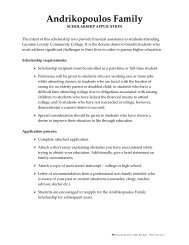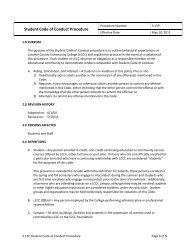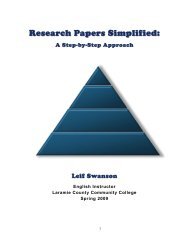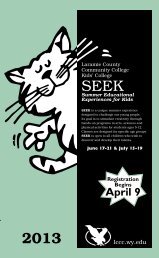LCCC policy - Laramie County Community College
LCCC policy - Laramie County Community College
LCCC policy - Laramie County Community College
Create successful ePaper yourself
Turn your PDF publications into a flip-book with our unique Google optimized e-Paper software.
HSEC 2003<br />
(3 cr.)<br />
Economics and Terrorism<br />
Students examine the impact of terrorist<br />
acts, the nature of finance in the Islamic<br />
countries, and the range of Islamic financial<br />
contracts. They compare the financial<br />
system used by Islamic countries with<br />
the system currently used in the United<br />
States. In addition, students profile the<br />
economic dimensions of crime (terrorism)<br />
and develop some tools for economic<br />
analysis. Finally, students explore<br />
historical evidence and current theories<br />
in order to develop an understanding of<br />
the potential economic impacts on the<br />
U.S. economy and how to mitigate such<br />
impacts. Prerequisite: Completion of<br />
HSEC 1000 or consent of instructor.<br />
HSEC 2004<br />
(3 cr.)<br />
Homeland Security<br />
and Law Enforcement<br />
Students receive an introduction to terrorism<br />
using a criminological or criminal<br />
justice framework for studying terrorist<br />
groups and individuals, terrorist origins,<br />
goals, dynamics, ideologies, counterterrorism,<br />
and homeland security. Students<br />
examine the structure and dynamics of<br />
terrorism, terrorist weapons, strategies<br />
and tactics, how they evolve, the ways in<br />
which they operate, how terrorists obtain<br />
funding, their use of the media, and<br />
theories of counterterrorism. Students<br />
review definitions of terrorism, analyze<br />
specific concepts, and examine issues<br />
that arise when responding to terrorism<br />
or the threat of terrorism. Prerequisite:<br />
Completion of ENGL 0700 or ENGL 1001<br />
or placement into ENGL 1010, or concurrently<br />
enrolled in ENGL 1010. (Crosslisted<br />
as CRMJ 2004.)<br />
HSEC 2005<br />
(3 cr.)<br />
Politics and Terrorism<br />
Students complete an historical overview<br />
of terrorism and formulate answers to<br />
the questions: What is terrorism? Who<br />
or what perpetrates terror? What are<br />
the motives and intentions of terrorists?<br />
Students develop a vocabulary<br />
and conceptual toolkit to understand<br />
terrorism domestically and internationally.<br />
Students examine political and<br />
religious fundamentalism, some of the<br />
cultural actors who played key roles in<br />
current movements, and the effects of<br />
these issues on individuals. They explore<br />
how social scientific tools can be used<br />
to understand conflict. Finally, students<br />
consider America’s war on terrorism and<br />
world politics. Prerequisite: The prerequisite<br />
for POLS 2128 is successful completion<br />
of POLS 1000 or consent of the<br />
instructor. Because there is a substantial<br />
writing component, completion of<br />
ENGL 1010 is also highly recommended.<br />
(Cross-listed as POLS 2128.)<br />
HSEC 2006<br />
(3 cr.)<br />
Terrorism and<br />
Weapons of Mass Destruction<br />
Students examine the proliferation of<br />
weapons of mass destruction (WMD):<br />
Chemical, Biological, Radiological,<br />
Nuclear, and Explosive (CBRNE) weapons<br />
that could cause massive casualties<br />
if used for terrorist attacks. Students<br />
examine the vulnerability of the U.S. populace<br />
to such weapons. Students explore<br />
strategies of how to prevent, limit,<br />
defend, and/or deter the use of weapons<br />
of mass destruction by terrorists. Finally,<br />
students examine the spread of CBRNE<br />
weapons and the threat of black market<br />
CBRNE weapons from the former Soviet<br />
arsenal. Prerequisites: Completion of<br />
ENGL 1010 and HSEC 1000 or consent of<br />
the instructor.<br />
HSEC 2007<br />
(3 cr.)<br />
Biological Terrorism<br />
Students explore the historic use of diseases<br />
or biological agents as weapons of<br />
war and terror with an emphasis on the<br />
symptomatic recognition of diseases and<br />
agents. They examine the epidemiology,<br />
microbiology, pathogenesis, prevention,<br />
and medical management of potential<br />
bioterrorism diseases/agents. They<br />
consider the characteristics of diseases<br />
and agents that are most suitable for use<br />
as biological weapons. Students explore<br />
the scientific and legal implications of<br />
quarantine as a public health tool for<br />
bioterrorism attacks. Students develop<br />
recommendations to increase our capacity<br />
to deal with the medical and public<br />
health consequences of potential bioterrorism<br />
attacks. Prerequisites: Completion<br />
of POLS 1000, ENGL 1010, and HSEC<br />
1000.<br />
HSEC 2008<br />
(3 cr.)<br />
Religion, Extremism, and Violence<br />
Students explore the basic tenets of the<br />
major religions and the history of violence<br />
within each religion. They compare<br />
and contrast the religions and identify<br />
areas with the most potential for misunderstanding<br />
and conflict. They examine<br />
the use of violence since 1800 as a means<br />
of extending a religious agenda and the<br />
implications of such violence in the 21st<br />
century. Students examine other extremist<br />
organizations which, although not a<br />
religious organization, exhibit a similar<br />
tendency to inspire some members to<br />
violence. Based on their examination<br />
of these religious and non-religious<br />
organizations, students formulate recommendations<br />
to reduce or redirect such<br />
violence into non-violent actions. Prerequisites:<br />
Completion of POLS 1000, ENGL<br />
1010, and HSEC 1000.<br />
HSEC 2009<br />
(3 cr.)<br />
Terrorism and the Media<br />
Students explore the role of traditional<br />
(print, radio, and television) and newer<br />
media technologies (especially softwarebased<br />
technologies) in the production,<br />
distribution, and reception of the news.<br />
Students examine the functions, roles,<br />
responsibilities, and behavior of the<br />
media in times of national and international<br />
threats to national security. They<br />
examine differing and competing perspectives<br />
of the government, terrorists,<br />
dissidents, the general public, and the<br />
media, and efforts by governments and<br />
terrorists to control the media and to use<br />
them as “tools” for their needs. Students<br />
consider how newer media technologies<br />
can or do amplify, transform, or counter<br />
the powers of these phenomena. Prerequisites:<br />
Completion of ENGL 1010 and<br />
HSEC 1000<br />
HSEC 2010<br />
(3 cr.)<br />
Cyber-Terrorism<br />
Students explore how the information<br />
revolution and America’s increasing utilization<br />
and reliance upon computers has<br />
affected societal infrastructure. Students<br />
examine the critical infrastructure composed<br />
of those systems and assets–both<br />
physical and cyber in nature–that are<br />
so vital that incapacitation or destruction<br />
would have a debilitating impact on<br />
national security, economic security, and/<br />
or public health and safety. Students look<br />
at how a ”networked” world has bred new<br />
crimes and new responses and investigate<br />
how the computer has become a<br />
tool, target, and place of criminal activity<br />
and national security threats, as well<br />
as a mechanism of response. Finally,<br />
students examine the convergence of<br />
existing laws, equities, and variables in<br />
this multidisciplinary area, along with the<br />
economic, cost-benefit conflicts that are<br />
created as a result of various competing<br />
concerns. Prerequisite: Completion of<br />
HSEC 1000.<br />
HSEC 2011<br />
(3 cr.)<br />
Homeland Security and<br />
Critical Infrastructure Networks<br />
Students participate in a comprehensive,<br />
in-depth examination of threats to<br />
critical infrastructure from a network perspective.<br />
Students consider the following<br />
key issues: critical infrastructure, U.S.<br />
defense of infrastructure from terrorist<br />
attack, the problem of too little money<br />
and too many infrastructure targets, and<br />
responsible persons/agencies and their<br />
roles. Students examine the seven general<br />
challenges in infrastructure protection:<br />
vastness, command, information<br />
sharing, knowledge, interdependencies,<br />
inadequate tools, and asymmetric conflict.<br />
Prerequisite: Completion of HSEC<br />
1015 or consent of the instructor.<br />
123


